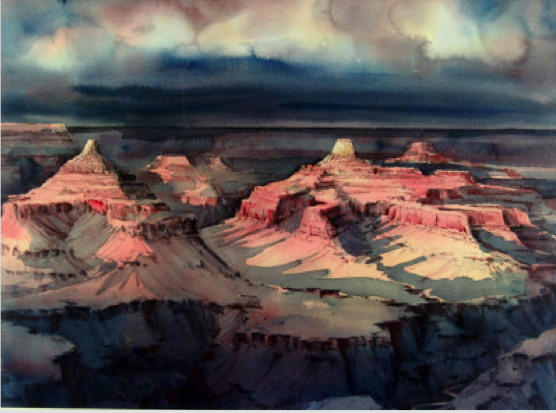In 2016, the National Park Service celebrated its 100th birthday! Capturing the Canyons reminds us how visual artists influenced the creation of the national parks that we enjoy today, many of which are in our own state of Utah.
Artists often accompanied explorers into these remote regions to document the amazing sites—waterfalls, geysers, giant Sequoia trees, and unusual rock formations. Their images were sent back East where they captured the attention of members of the U.S. Congress, who realized the importance of protecting and safeguarding these precious lands. This marked the establishment of our national parks.
Exploring the Artwork

Watercolor Discoveries: Rather than photographing a scene and painting it later in their studio, many artists choose to paint right outdoors where they can experience the views first-hand. This is called plein air painting. In the 19th century, when cameras were extremely heavy and difficult to carry around, many artists preferred to document outdoor scenery with watercolors, which were much easier to transport and dried very quickly. •Why do you think some artists like to paint outdoors rather than in their studio? •If you were going to paint outdoors, what supplies would you need to take with you?
An Artist's Eye: While many landscape artists attempt to accurately paint what they actually see—like a realistic photograph—other artists prefer to capture what they experience in a more abstract way. The images and forms in abstract paintings seem to occur more from the imagination of the artist than from real life. For example, at the rock formation in Zion National Park called the Temple of Sinawava, this is what the artist saw:

However, this is how he chose to represent what he was seeing:

•How are the photograph and the painting alike? How are they different? •Using one word, how would you describe the mood of this watercolor painting? •How does the artist create the mood of the painting using line, shape, and color?
Watercolor Techniques: Many artists enjoy using watercolor paint because of the many different techniques it allows. For example, bolder colors (less saturated) are made by using less water, whereas gentler colors are created using more water. Artists also allow the colors to run together to make brand new colors. Sometimes you can even see the paper beneath the paint. See Ronald Bergen’s Canyon Shadows below:

•What watercolor techniques has the artist used? Where are the colors bolder? Where are they more “watery”? Where do the colors run together? •What do the colors of the painting tell you about the time of day? The time of year?
Art Activity
In the gallery you learned that plein air painting occurs OUTDOORS. Now you can try plein air watercolor painting yourself, just like the national parks artists in Capturing the Canyons.
What You Will Need: 1. Gather any/all of the following supplies: 1 pencils 3 pieces of paper 1 foam boards 2 paint brushes 2 plastic cups 1 watercolor paint trays 6 paper towels 1 bottle of water 1 large piece of burlap for sitting 2. Go outside anywhere—on the grass, sidewalk, or your porch steps—where you can enjoy a great view of nature and the outdoors. 4. Decide on the piece of nature you want to paint. Place your paper on the foam board, and FIRST draw it out with pencil. 5.Then fill your cup with an inch of water, take out a brush and paint tray, and start painting! Remember: Always paint the lighter colors first and the darker colors last. 6. Send us your masterpiece! Post on social media with #byumoa and #moafromhome
Try plein air painting whenever you go someplace new. On your next family vacation—or even on your next backyard adventure—you can bring your own paints, water, and brushes to paint the great outdoors. Try painting not only landscapes, but also the details of nature such as a single flower or leaf. Keep and collect your watercolor paintings as memories of your experiences.